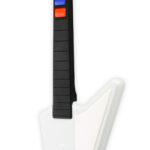If you’re tired of tripping over cables and feeling tethered to your amp, it’s time to explore the freedom of the Best Guitar Wireless Systems. Modern technology offers a plethora of options that cater to every guitarist’s needs, whether you’re rocking out on stage, practicing in your rehearsal space, or simply jamming at home without the cable clutter.
Forget struggling with complicated setups. Today’s best guitar wireless systems are designed for ease of use, offering plug-and-play operation right out of the box. With varying wireless ranges, battery life, and channel options, finding the perfect system for your specific situation is easier than ever. Whether you need a compact pedalboard-friendly unit or a robust system for larger stages, our guide will help you navigate the options.
Choosing the right wireless system can seem daunting, but we’ve simplified the process. We’ve compiled a list of what we consider the best guitar wireless systems available today, covering a range of budgets and requirements. Our expert writers, all experienced musicians, have rigorously tested these products to ensure you get reliable recommendations and the best possible wireless guitar experience.
Best Guitar Wireless Systems: Top Picks
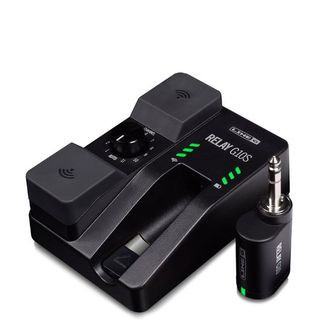 Best guitar wireless systems: Line 6 Relay G10S
Best guitar wireless systems: Line 6 Relay G10S
1. Line 6 Relay G10S: Best Overall
The Line 6 Relay G10S wireless guitar system, a top pick for overall performance, offering great range and pedalboard integration.
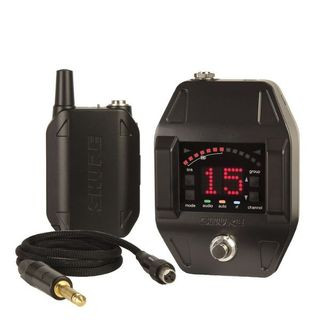 Best guitar wireless systems: Shure GLX-D16
Best guitar wireless systems: Shure GLX-D16
2. Shure GLX-D16: Best Pro Option
The Shure GLX-D16 professional guitar wireless system, known for its rugged build, pedalboard tuner, and reliable frequency management.
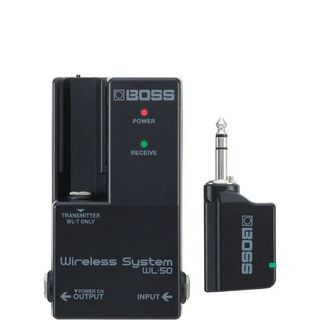 Best wireless guitar systems: Boss WL-50
Best wireless guitar systems: Boss WL-50
3. Boss WL-50: Best for Pedalboards
The Boss WL-50 pedalboard-friendly wireless system, offering excellent sound quality, low latency, and convenient integration with pedal setups.
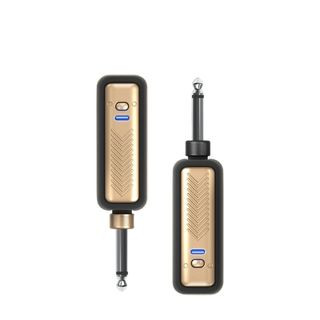 Best guitar wireless systems: Positive Grid Spark Link
Best guitar wireless systems: Positive Grid Spark Link
4. Positive Grid Spark Link: Best for Simplicity
The Positive Grid Spark Link wireless guitar system, a user-friendly option for simple setup and robust wireless connection, ideal for beginners.
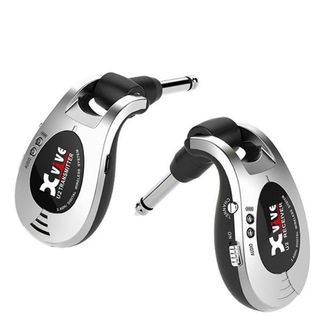 Best guitar wireless systems: XVive U2
Best guitar wireless systems: XVive U2
5. XVive U2: Best Value
The XVive U2 budget-friendly wireless guitar system, providing excellent value with impressive range and audio quality in a compact design.
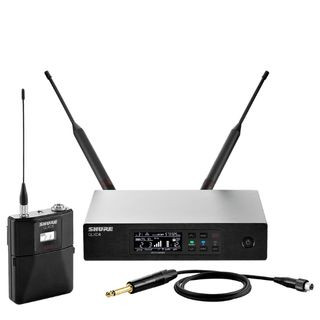 Best guitar wireless systems: Shure QLXD14 Wireless Guitar System
Best guitar wireless systems: Shure QLXD14 Wireless Guitar System
6. Shure QLXD14: Best Range
The Shure QLXD14 professional wireless guitar system, offering exceptional wireless range and advanced features for large stages and professional use.
Best Overall
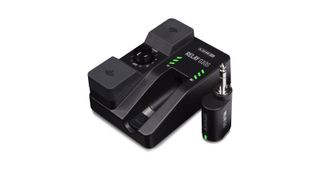 Best guitar wireless systems: Line 6 Relay G10S
Best guitar wireless systems: Line 6 Relay G10S
Line 6 Relay G10S wireless guitar system receiver and transmitter on a pedalboard, demonstrating its compact and stage-ready design.
1. Line 6 Relay G10S
Plug-and-Play Wireless Freedom for Guitarists
Expert Review:
Specifications
- Range: Up to 130 feet line-of-sight
- Latency: Not specified (negligible)
- Dynamic Range: >112dB
- Operating Band: 2.4GHz
- Sample Rate: 24-bit
Pros
- Exceptional wireless range for stage freedom
- Versatile functionality as a DI box
- Convenient rechargeable battery
Cons
- Potential compatibility issues with active pickups
At a Glance:
✅ Ideal for: Guitarists seeking a user-friendly, pedalboard-compatible wireless system for live performances and practice. The Line 6 G10S excels in simplicity and reliable performance.
❌ Consider other options if: You primarily use guitars with active pickups due to potential incompatibility, which may require additional adapters or solutions.
The Line 6 Relay G10S is engineered for both guitar and bass, seamlessly integrating into your pedalboard setup or functioning as a standalone unit beside your guitar amplifier. Its transmitter, equipped with a standard 1/4-inch connector, effortlessly plugs into your guitar’s output jack, similar to a Wi-Fi dongle, ensuring a secure and straightforward connection.
Boasting a full frequency response and an expansive dynamic range, the G10S preserves the integrity of your guitar signal, preventing unwanted compression on its path to your amplifier. Delivering 24-bit lossless digital audio quality, coupled with Line 6’s innovative Cable Tone technology, which emulates the subtle capacitance of a traditional guitar cable, the Relay G10S stands out as an exceptional wireless system at its price point, offering hassle-free setup and professional-grade performance. It’s a top contender for players looking for the best guitar wireless system that balances quality and ease of use.
Best Pro Option
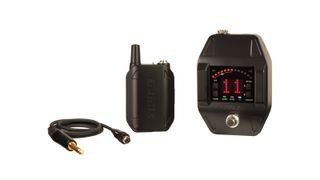 Best guitar wireless systems: Shure GLX-D16
Best guitar wireless systems: Shure GLX-D16
The Shure GLX-D16 wireless guitar system with pedal receiver and bodypack transmitter, highlighting its professional-grade components and stage-ready design.
2. Shure GLX-D16
Professional-Grade Wireless Performance for Demanding Guitarists
Expert Review:
Specifications
- Range: 65-100 feet (20-30m) typical indoor range
- Latency: Not specified (negligible)
- Frequency Response: 20Hz – 20kHz
- Dynamic Range: 120dB
- Operating Band: 2.4GHz
- Sample Rate: Not specified
Pros
- Pedalboard-mountable receiver for seamless integration
- Integrated, highly visible onboard tuner
- Automatic frequency management for uninterrupted performance
Cons
- Higher price point compared to other systems
At a Glance:
✅ Ideal for: Professional and serious gigging guitarists needing a robust, feature-rich wireless system for live performances. The Shure GLX-D16 offers exceptional reliability and advanced features for stage use.
❌ Consider other options if: Budget is a primary concern, as this system represents a significant investment compared to entry-level or mid-range wireless options.
The Shure GLX-D16 system is a comprehensive package designed for the professional guitarist. It includes Shure’s pioneering pedalboard receiver, the GLX-D6, the GLX-D1 bodypack transmitter, and the WA305 premium guitar cable with a secure locking TA4F connector. The robust build quality of each component inspires confidence, promising durability and reliability in demanding live environments.
The GLX-D6 receiver’s metal chassis is built to withstand the rigors of stage use, designed to endure being stepped on and handled frequently. A standout feature is its bright LED tuner, offering both strobe and needle display modes for precise and easy tuning directly from your pedalboard. Equipped with Shure’s LINKFREQ Automatic Frequency Management, the GLX-D16 continuously scans for the clearest channel, seamlessly switching frequencies to avoid interference and ensure a consistently strong signal. This intelligent frequency management system is invaluable for maintaining uninterrupted performance in unpredictable wireless environments, making it a top choice for the best professional guitar wireless system.
Best for Pedalboards
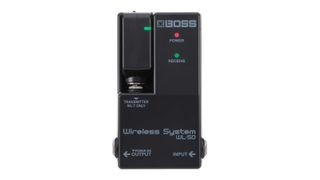 Best guitar wireless systems: Boss WL-50
Best guitar wireless systems: Boss WL-50
Boss WL-50 guitar wireless system integrated on a pedalboard, showcasing its compact stompbox design and seamless pedalboard compatibility.
3. Boss WL-50 Guitar Wireless System
Pedalboard Perfection: Wireless Freedom in a Stompbox
Expert Review: Boss WL-50 Review Link
Specifications
- Range: 65 feet line-of-sight
- Latency: 2.3ms (ultra-low)
- Frequency Response: 20Hz – 20kHz
- Dynamic Range: >110dB
- Operating Band: 2.4GHz
- Sample Rate: Not specified
Pros
- Effortless operation and reliable performance
- Integrated DC output for powering pedals
- Impressive battery life with convenient USB charging
Cons
- Potential incompatibility with active pickups
At a Glance:
✅ Ideal for: Guitarists who prioritize pedalboard integration and need a compact, high-quality wireless system that fits seamlessly with their existing pedals. The Boss WL-50 is designed for pedalboard users seeking convenience and excellent sound.
❌ Consider other options if: You primarily use guitars equipped with active pickups, as this system, similar to the Line 6 G10S, may encounter compatibility issues due to wiring configurations.
True to Boss’s reputation for pedalboard innovation, the WL-50 receiver is designed to sit comfortably amongst your stompboxes, delivering exceptional sound quality and convenience without compromising pedalboard real estate. In our testing, the WL-50 demonstrated ultra-low latency, preserving the responsiveness of your playing, along with excellent dynamics and a full frequency response to maintain your guitar’s natural tone. Its 65-foot range provides ample freedom for stage movement, and the inclusion of two onboard cable simulation circuits allows you to subtly adjust the system’s tone to mimic the slight capacitance effect of different guitar cables, adding a touch of familiarity for players accustomed to wired setups. It truly embodies what guitarists seek in a top-tier pedalboard guitar wireless system.
A single charge provides up to 12 hours of playtime, ensuring reliable performance throughout gigs and rehearsals. The receiver also features a DC output, allowing it to power other pedals on your board, further streamlining your setup. The WL-50 is designed for compatibility with most guitars and basses equipped with passive pickups, making it a versatile choice for a wide range of players.
Read our full Boss WL-50 review
Best for Simplicity
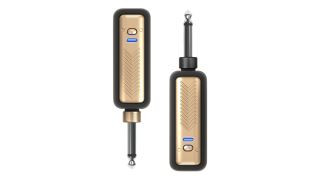 Best guitar wireless systems: Positive Grid Spark Link
Best guitar wireless systems: Positive Grid Spark Link
Positive Grid Spark Link wireless guitar system, highlighting its ultra-compact design and ease of use for quick setup and play.
4. Positive Grid Spark Link
Effortless Wireless: Plug, Play, and Spark Your Creativity
Expert Review: Positive Grid Spark Link Review Link
Specifications
- Range: 70 feet (21 meters)
- Latency: <3ms (near-instantaneous)
- Dynamic Range: Not specified
- Operating Band: 2.4GHz
- Sample Rate: 24-bit/48kHz
Pros
- Extremely easy and quick setup process
- Excellent audio fidelity and clear sound
- Impressive wireless range for home and practice use
Cons
- Lacks a dedicated pedalboard charging solution for live use
At a Glance:
✅ Ideal for: Guitarists who value simplicity and ease of use above all else. The Positive Grid Spark Link is perfect for beginners and players who want a hassle-free wireless experience for home practice and jamming.
❌ Consider other options if: You need a wireless system primarily for live performances and require pedalboard-integrated charging or robust stage features.
The Positive Grid Spark Link, from the innovative creators of Spark smart amps, is designed for seamless integration with their amp ecosystem but offers versatile compatibility for any guitarist. This wireless system prioritizes user-friendliness and immediate connectivity.
Pairing the Spark Link is remarkably fast, often taking less than a minute, making it an ideal choice for first-time wireless users or anyone who appreciates a straightforward setup. Its near-instantaneous pairing process gets you playing quickly, without technical fuss. The Spark Link delivers phenomenal sound quality and a reliable signal. In our tests, it maintained a strong connection throughout a typical home environment, even near a Wi-Fi router, demonstrating excellent resistance to interference. The only notable limitation is the absence of a dedicated pedalboard charging option, which might slightly reduce its appeal for live performance scenarios where continuous power and pedalboard integration are essential. However, for ease of use and sound quality, it stands out as a top simple guitar wireless system.
Read the full Positive Grid Spark Link review
Best Value
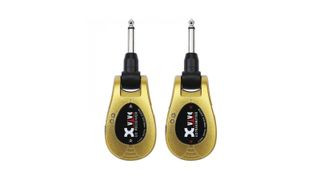 Best guitar wireless systems: XVive U2 Gold
Best guitar wireless systems: XVive U2 Gold
XVive U2 wireless guitar system in gold finish, showcasing its compact dongle design and affordable price point for budget-conscious musicians.
5. XVive U2
Unbeatable Wireless Value: Professional Features Without Breaking the Bank
Expert Review:
Specifications
- Range: >70 feet line-of-sight outdoors
- Latency: 6ms (minimal delay)
- Frequency Response: 20Hz – 20kHz
- Dynamic Range: >103dB
- Operating Band: 2.4GHz
- Sample Rate: 24-bit/48kHz
Pros
- Exceptional value for money in the wireless market
- More than sufficient range for small to medium-sized gigs
- Simple plug-and-play setup with convenient right-angled connections
Cons
- Dongle design may not appeal to all aesthetic preferences
At a Glance:
✅ Ideal for: Budget-conscious guitarists seeking a reliable wireless system without compromising on performance. The XVive U2 offers incredible value, making wireless freedom accessible to more players.
❌ Consider other options if: Visual aesthetics are a top priority, as the dongle-style design might not be the most visually integrated solution for all guitar setups.
Despite its unassuming dongle-style construction and remarkably affordable price, the XVive U2 delivers impressive performance and sound quality. It offers a respectable wireless range, a full frequency response that accurately reproduces your guitar’s tone, and excellent audio quality transmission. With only 6ms of latency, the delay is virtually imperceptible, ensuring a natural playing experience. This combination of performance and price makes it a standout choice, recognized as one of the best value guitar wireless systems available.
While some users might find the transmitter and receiver dongles less visually refined, the XVive U2 prioritizes functionality and performance where it matters most. For guitarists seeking an easy-to-use, high-performing wireless system at an accessible price point, the XVive U2 is hard to beat. It’s available in various finishes, including gold, to match your guitar’s hardware. The rechargeable lithium-ion batteries provide up to five hours of playtime, suitable for most gigs and practice sessions.
Best Range
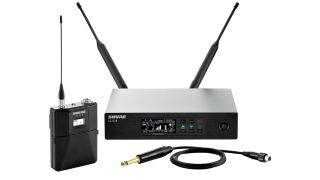 Best guitar wireless systems: Shure QLXD14 Wireless Guitar System
Best guitar wireless systems: Shure QLXD14 Wireless Guitar System
Shure QLXD14 Wireless Guitar System with bodypack transmitter and rack-mountable receiver, emphasizing its professional features and extended wireless range for large venues.
6. Shure QLXD14 Wireless Guitar System
Unleash Your Stage Presence: Professional Wireless with Maximum Range
Expert Review:
Specifications
- Range: 328 feet (100m)
- Latency: Not specified
- Dynamic Range: >120dB
- Operating Band: G50/H50/J50A/V50/X52 (region-specific)
- Sample Rate: 24-bit
Pros
- Extensive wireless range for large stages and venues
- Effortless pairing via infrared (IR) sync
- AES-256 encryption for secure signal transmission
Cons
- Feature-rich system may be complex for beginners
At a Glance:
✅ Ideal for: Professional guitarists performing on large stages or needing maximum wireless range and advanced security features. The Shure QLXD14 is a top-tier system for demanding professional environments.
❌ Consider other options if: You are new to wireless systems or prefer a simpler, more streamlined setup, as the QLXD14’s extensive features might be overwhelming for basic use.
For professional guitarists who command large stages or require extended wireless range, the Shure QLXD14 Wireless Guitar System is a top-of-the-line solution. Packed with professional-grade features and designed for reliable connectivity, this system is built for serious performers who demand the best.
The QLXD14 boasts an impressive 328-foot (100-meter) range, providing unparalleled freedom to move across even the largest stages. Unlike simpler “bug”-style transmitters, it features a robust bodypack transmitter that connects to a rack-mountable receiver, ensuring a secure and professional setup. Pairing is simplified with IR sync, allowing for quick and easy channel setup. Constructed for the rigors of touring, the QLXD14 features an all-metal build for durability and includes rack-mounting hardware for seamless integration into professional audio setups. It transmits crystal-clear 24-bit audio and incorporates AES-256 encryption, ensuring secure signal transmission and protecting against unauthorized interception. For professionals seeking the best long-range guitar wireless system with advanced features, the Shure QLXD14 is the definitive choice.
More Options…
Our top picks offer a range of excellent choices, but the world of wireless guitar systems is vast. Here are a few more noteworthy options to consider if you’re looking for something slightly different.
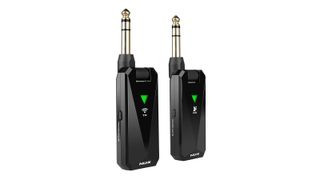 Best guitar wireless systems: NUX B-5RC
Best guitar wireless systems: NUX B-5RC
NUX B-5RC wireless guitar system with portable charging case, highlighting its versatility and convenient charging solution for multiple instruments.
7. NUX B-5RC
Versatile Wireless for All Your Electric Instruments
Expert Review:
Specifications
- Range: Up to 100 feet (30m) line-of-sight
- Latency: Not specified (negligible)
- Frequency Response: 20 Hz – 20 kHz
- Dynamic Range: >112dB
- Operating Band: 2.4GHz
- Sample Rate: 24-bit
Pros
- Compatible with a wide range of electric instruments
- Included portable charging case for extended use
- Simple, plug-and-play operation with no setup required
Cons
- Some users report potential interference near Wi-Fi routers
At a Glance:
✅ Ideal for: Musicians who play multiple electric instruments and need a versatile, easy-to-use wireless system that can handle guitars, basses, ukuleles, and more. The NUX B-5RC is a great all-in-one wireless solution.
❌ Consider other options if: You frequently play in environments with strong Wi-Fi signals, as some users have reported occasional interference issues in close proximity to routers.
The NUX B-5RC stands out for its exceptional plug-and-play simplicity. Designed for immediate use straight out of the box, it features automatic frequency matching, eliminating any complicated setup procedures. Its versatility extends to compatibility with various electric instruments, including electric guitars, acoustic-electric guitars, bass guitars, and ukuleles, accommodating both active and passive pickups, as well as piezo and magnetic pickups. This makes it an excellent choice for musicians who switch between different types of instruments.
With a 15-hour playtime per charge and a portable charging case that can recharge the unit up to three times, the B-5RC is well-suited for touring and extended use. It delivers high-quality, zero-latency performance at a price point accessible to amateur and professional musicians alike. Its broad instrument compatibility makes it a truly versatile best wireless system for multiple guitars and instruments.
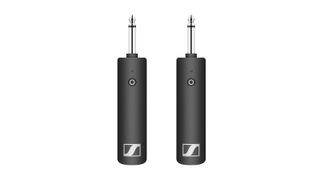 Best guitar wireless systems: Sennheiser XSW-D
Best guitar wireless systems: Sennheiser XSW-D
Sennheiser XSW-D Instrument Base Set, showcasing its sleek dongle design and professional audio quality from a leading audio brand.
8. Sennheiser XSW-D Instrument Base Set
Professional Audio Heritage, Wireless Freedom for Guitarists
Expert Review:
Specifications
- Range: 250 feet (75m) in optimal conditions
- Latency: Not specified (<4ms in testing)
- Frequency Response: 10Hz – 18kHz
- Dynamic Range: >106dB
- Operating Band: 2.4GHz
- Sample Rate: Not specified
Pros
- Excellent audio performance and robust design from Sennheiser
- Convenient and fast ‘one-touch’ setup
- Automatic frequency management for reliable signal
Cons
- Higher price point reflecting its professional quality
At a Glance:
✅ Ideal for: Guitarists who prioritize audio quality and want a fast, reliable wireless system with professional-grade performance from a trusted audio brand like Sennheiser.
❌ Consider other options if: Budget is a primary constraint, as the Sennheiser XSW-D represents a premium investment for its advanced features and brand reputation.
The Sennheiser XSW-D Instrument Base Set offers a refined take on the dongle-style wireless system, combining ease of use with Sennheiser’s renowned audio quality. Designed for high performance and simplicity, the XSW-D features a ‘one-touch’ setup for incredibly fast pairing and operation. In our tests, latency was measured at less than 4ms, ensuring a virtually imperceptible delay for a natural playing feel. The XSW-D boasts a significant maximum range of 250 feet under optimal conditions, exceeding the needs of most performance environments.
The system provides visual feedback on signal strength, with the transmitter and receiver LEDs flashing green and red to indicate a weakening signal. Charging is convenient via USB, allowing for flexible power options from any USB port or charger. The Sennheiser XSW-D is a testament to professional audio quality in a user-friendly wireless format, making it a top professional guitar wireless system for discerning musicians.
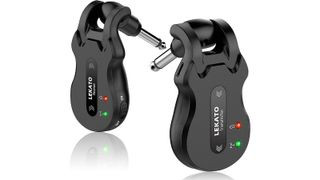 Best guitar wireless systems: Lekato 5.8 GHz Wireless Guitar System
Best guitar wireless systems: Lekato 5.8 GHz Wireless Guitar System
Lekato 5.8 GHz Wireless Guitar System, emphasizing its budget-friendly price and 5.8GHz operation for reduced Wi-Fi interference.
9. Lekato 5.8 GHz Wireless Guitar System
Budget Wireless Champion: Reliable Performance Without the Premium Price Tag
Expert Review:
Specifications
- Range: 100 feet (30m)
- Latency: 5.6ms (negligible)
- Frequency Response: 20Hz – 20kHz
- Dynamic Range: 100dB
- Operating Band: 5.8GHz
- Sample Rate: 24-bit/48kHz
Pros
- Very easy to set up and use, ideal for beginners
- 5.8GHz band reduces interference from Wi-Fi and Bluetooth devices
- Exceptional value for money, one of the most affordable options
Cons
- Reported incompatibility with active pickups in some guitars
At a Glance:
✅ Ideal for: Guitarists seeking an affordable entry into wireless systems without sacrificing reliability. The Lekato 5.8 GHz system offers excellent value for money and ease of use.
❌ Consider other options if: You use guitars with active pickups, as this system may present compatibility issues due to its TRS jack configuration.
The Lekato 5.8 GHz Wireless Guitar System is an outstanding option for guitarists looking to go wireless without a significant investment. It prioritizes ease of use, offering a simple setup process that works right out of the box. Operating on the 5.8GHz band, it significantly reduces the risk of interference from common 2.4GHz devices like Wi-Fi routers, Bluetooth devices, and other household electronics, providing a cleaner and more reliable wireless signal. Its affordability is a major highlight, making it one of the most accessible wireless systems available, often priced under $100.
Despite its budget-friendly price, the Lekato delivers reliable performance, with a 100-foot range suitable for most stage sizes and a minimal 5.6ms latency that is virtually undetectable. While its 5-hour battery life may require more frequent charging than some premium models, it is generally sufficient for typical gigs and practice sessions. For those seeking the best budget guitar wireless system that doesn’t compromise on essential features, the Lekato 5.8 GHz system is a compelling choice.
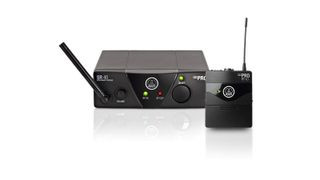 Best guitar wireless systems: AKG WMS40 Mini Wireless Instrument Set
Best guitar wireless systems: AKG WMS40 Mini Wireless Instrument Set
AKG WMS40 Mini Wireless Instrument Set, highlighting its compact design and exceptional 30-hour battery life for extended performance.
10. AKG WMS40 Mini Wireless Instrument Set
Long-Lasting Budget Wireless: Extended Battery Life for Marathon Performances
Expert Review:
Specifications
- Range: 150 feet typical (300 feet line-of-sight)
- Latency: Not specified
- Dynamic Range: >100 dB
- Operating Band: Various (region-specific)
- Sample Rate: Not specified
Pros
- Exceptional 30-hour battery life for extended playing sessions
- Affordable price point, making it a budget-friendly option
- Simple and intuitive plug-and-play operation
Cons
- Single frequency range may be susceptible to interference in certain environments
At a Glance:
✅ Ideal for: Guitarists who need extended battery life for long gigs or practice sessions and are looking for a reliable, budget-friendly wireless system from a reputable brand.
❌ Consider other options if: You are concerned about potential wireless interference in environments with heavy RF activity, as the single frequency range might be less flexible than multi-channel systems.
AKG, a respected name in microphone technology, brings its audio expertise to the WMS40 Mini Wireless Instrument Set. Designed to preserve your guitar’s natural tone, the WMS40 delivers a clear and transparent sound. It stands out as a top budget option, offering professional features at an accessible price.
Ease of use is a key feature of the AKG WMS40. Its plug-and-play operation requires minimal setup – simply connect the transmitter to your guitar, power on the receiver, and the system automatically finds a clear channel. It provides a hassle-free wireless experience, especially for beginners. The most remarkable feature is its exceptional 30-hour battery life, powered by a single AA battery, making it ideal for extended gigs, rehearsals, or long practice sessions. While not the most feature-rich system, the AKG WMS40 excels in reliability, ease of use, and extended battery performance, making it a strong contender for the best budget guitar wireless system with long battery life. Its compact size further enhances its portability and convenience for gigging musicians.
Best Guitar Wireless Systems: Buying Advice
 Best guitar wireless systems: Boss guitar wireless system in use
Best guitar wireless systems: Boss guitar wireless system in use
Close-up of a Boss wireless guitar system in use, highlighting the freedom and mobility wireless technology offers to guitarists during performance.
What to Look for in the Best Guitar Wireless Systems
Guitar World Expertise: Trusted Reviews for Guitarists
At Guitar World, our expert reviewers dedicate countless hours to testing and comparing guitar gear to help you make informed decisions. Learn more about our testing process.
When choosing the best guitar wireless system for your needs, consider a few key factors. While most modern systems are user-friendly with plug-and-play setups, asking yourself the right questions beforehand will ensure you select the ideal system for your playing style and performance requirements.
What is a Wireless Guitar System?
A wireless guitar system essentially replaces the traditional guitar cable, providing freedom of movement without sacrificing sound quality. It typically consists of two main components: a transmitter and a receiver. The transmitter, connected to your guitar, encodes your guitar’s signal and wirelessly sends it to the receiver. The receiver, in turn, decodes the signal and outputs it to your amplifier or pedalboard, just as if you were using a standard guitar cable.
Transmitters can come in various forms. Some feature a built-in jack that plugs directly into your guitar, while others use a bodypack transmitter connected via a short cable. Receivers also vary in design; some are compact pedal-style units designed to sit on your pedalboard, while others are larger units intended for amp tops or rack mounting. Pedalboard receivers often accept standard 9V power supplies, simplifying integration with your pedal setup. Many modern systems utilize rechargeable batteries, offering convenience and eliminating the need for disposable batteries.
Wireless Range:
Wireless range is a crucial specification to consider. If you perform on large stages or enjoy moving around the venue, prioritize systems with a longer range. A generous range is also beneficial during soundchecks, allowing you to assess your sound from different areas of the venue. For home practice or smaller stages, a shorter range system will suffice.
Channels:
For performances at medium to large venues, especially when sharing the stage with other bands using wireless equipment, channel selection becomes important. Multiple channels allow you to switch frequencies if interference occurs, ensuring a clean and uninterrupted signal. Professional-grade systems often offer multiple channel options and frequency bands for maximum flexibility and reliability.
Quality:
As with most audio equipment, quality often correlates with price. While budget-friendly systems can provide basic wireless functionality, higher-end models are engineered to preserve your guitar’s tone more accurately. A higher quality transmitter and receiver will maintain the integrity of your frequency response, ensuring your highs and lows are faithfully reproduced, which is essential for players who are particular about their tone. Investing in a high-quality guitar wireless system can make a noticeable difference in sonic fidelity.
How Much Should I Spend on a Guitar Wireless System?
Determining your budget for a guitar wireless system depends largely on your intended use. While top-of-the-line, expensive systems offer premium features and performance, they may be overkill for casual use.
For home practice, rehearsals, or small club gigs, mid-range and even budget-friendly systems often provide excellent value and sufficient performance. Systems in the sub-$250 price range, such as the Line 6 Relay G10S, Boss WL-50, and NUX B-5RC, offer a great balance of features and affordability, suitable for most non-professional applications.
If you perform regularly on larger stages, prioritize durability, extended range, and potentially improved tone, investing in a higher-priced system ($250+) may be justified. While more expensive systems may offer incremental improvements in tone and durability, the tonal benefits often diminish beyond a certain price point, so consider your needs and budget carefully when selecting the best guitar wireless system for you.
Do Guitar Wireless Systems Work with Active Pickups?
Compatibility with active pickups is a common question. Some wireless systems may not be fully compatible with guitars equipped with active pickups due to differences in TRS jack output configurations. Always check the manufacturer’s specifications and your guitar’s compatibility before purchasing a wireless system.
If you encounter compatibility issues with active pickups, a simple workaround may involve using a 1/4-inch adapter or a 1/4-inch to 1/4-inch mono patch cable to ensure proper signal transmission. Consulting with the wireless system manufacturer or a knowledgeable guitar technician can also provide specific solutions for active pickup compatibility.
How We Choose Guitar Wireless Systems
 Testing the Boss WL50 wireless system
Testing the Boss WL50 wireless system
Guitar World expert reviewer testing the Boss WL-50 wireless guitar system, evaluating its performance, ease of use, and sound quality in a real-world playing scenario.
Guitar World’s Rigorous Testing Methodology
Guitar World is a leading authority in guitar gear reviews, staffed by experienced musicians and industry experts. Our team rigorously tests and evaluates countless guitar products, including a wide range of guitar wireless systems, to provide you with reliable and unbiased recommendations. As passionate guitarists ourselves, we understand the importance of achieving optimal tone and eliminating cable-related hassles.
Our selection process for the best guitar wireless systems combines hands-on testing, user feedback analysis, and in-depth discussions among our editorial team. We evaluate key factors such as price, wireless range, latency, battery life, ease of use, and sound quality to ensure our recommendations represent the best options available on the market.
Our goal is to empower guitarists to find the perfect wireless system that meets their specific needs and enhances their performance. We are committed to providing knowledgeable and trustworthy guidance to help you unlock your full potential and experience the freedom of wireless guitar playing with the best guitar wireless systems.
Read more about how we test at Guitar World.


